AIZEN Bulletin
2011/2012
THE AIZEN CELEBRATES 20 YEARS OF EXISTENCE!
Report on the Pusan Conference, marking the 20th
Anniversary of the AIZEN

The AIZEN celebrated its 20th anniversary in Pusan, a sparkling jewel of a city on the southeast coast of South Korea, from October 6 to 8, 2011. “Worldwide Naturalism in Literature and Film” was the title of the AIZEN’s 16th international conference, organized jointly with Pusan National University, which brought together more than eighty participants representing four continents and fifteen countries: Canada, the USA, Brazil, France, Norway, Sweden, Finland, Russia, Moldova, Tunisia, Japan, Korea, China, Taiwan, and New Zealand. We thank conference-goers for responding with enthusiasm, coming from so far, and contributing to the excellent intellectual level of the offerings.

Busan festivities
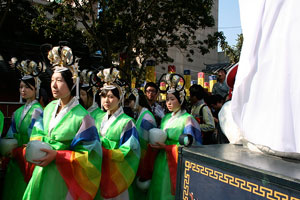
The conference took place at the Pusan National University and was jointly sponsored by this institution, one of the most respected in Korea. Our heartfelt thanks go to Dean of the Graduate School Tae-Heum Cho for the support he gave to this event. Our deepest thanks also go to Sang-Koo Kim, Professor Emeritus of American Literature from this university and long-time member of the AIZEN, for approaching Anna Gural-Migdal, President of the AIZEN, with the invitation to hold a conference at PNU. They worked closely together for three years to prepare this conference, each with respective teams. In South Korea, Sang Koo Kim collaborated with his colleagues at PNU, Il-Jae Jo, Chair of the Department of English Language Education, and Wang Joo Lee, Director of the Film Institute; from her location at the University of Alberta, in Canada, President of the AIZEN Anna Gural-Migdal worked with Carolyn Snipes-Hoyt, Secretary-Treasurer of the AIZEN, colleagues Jeremy Worth and Riikka Rossi, from the universities of Windsor and Helsinki, respectively, and University of Alberta Graduate Student Assistant Justine Huet.

Sang-Koo Kim welcoming Anna Gural-Migdal
Those of us fortunate enough to be part of the AIZEN organizational group were graciously invited by the Korean organizers to a copious luncheon in a Chinese restaurant. This was an excellent start to our collaboration in person with our Asian colleagues before the conference and set the tone for the festivities to follow, as was our visit to Pusan’s Castle Wall. In the evening, we were able to visit the Tong Dosa Temple, an ancient site perched on top of the hill behind the city. As we observed a monk beating on a giant drum and listened to its echoing boom in the faintly glowing evening lights, we felt transported to another world.

Left: Chinese Luncheon with the Organizing Committee

Right: Tong Dosa Temple
All conference participants were touched by the attentive hospitality of our Korean hosts and their sensitivity to the fact that, for many of us, this was a first encounter with Asia. Indeed, the Pusan conference represents yet another bridge built between researchers from many cultures. Since the AIZEN’s first conference, which took place in Boston in 1991, its development of trans-disciplinary and comparative research on Zola and naturalism has significantly broadened the field. And, in the last fifteen years, the AIZEN has made an effort to insure its expansion throughout the world by organizing its conferences outside the English- and French-speaking world, for example, in Spain, Brazil, and Finland. 2011 marks the first AIZEN conference in Asia, an experience which enabled participants to become acquainted with the research of scholars from this part of the world.
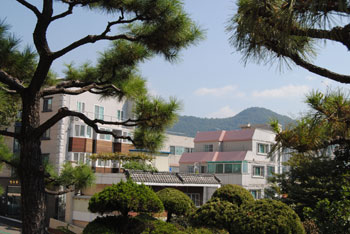
Pusan National University Campus
On Thursday morning, the members of the local organizational committee, Sang-Koo Kim, Il-Jae Jo, Wang Joo Lee, as well as Anna Gural-Migdal, President of the AIZEN and Tae-Heum Cho, Dean of the Graduate School, gave their opening speeches at the National University of Pusan. The sessions began immediately after, the topics of the twenty-one sessions dealing with literature and film considered from comparative and interdisciplinary perspectives.

Left: Dean Tae-Heum Cho and
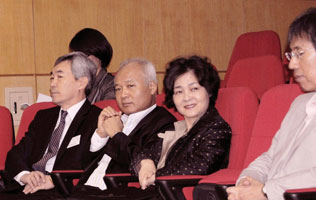
Right: Dean Tae-Heum Cho, Il-Jae Jo, Je-Boon Yu, and Wang Joo Lee
The conference began with a session presided by Hyung-Sub Park and Riikka Rossi: “The Reception of French Naturalist Writers in Korea.” Jaeryong Cho and Jihyun Kim presented a paper on the earliest reception of naturalism in Korea, via double-translation, while Young-Rae Ji and Ji-Young Hwang discussed three Korean authors from the years 1920-1930. Myoung A. Kwon analyzed the Zola’s influence during the Colonial Period. Joo-Kyoung Son, Hyo-Jeong Wi and Hwa-in Shin presented a paper on the first Korean translation of Daudet. A second session ran simultaneously, chaired by Carolyn Snipes-Hoyt and titled “From Naturalism to Modernity: From West to East,” enabling us to hear from Hélène Poiré, Ki-Hwan Yu, Lisa Ng and Mélanie Giraud, whose papers compared Zola’s works to those of Yi In-Jik, Shimazaki Toson and Yom Sang-Seop.
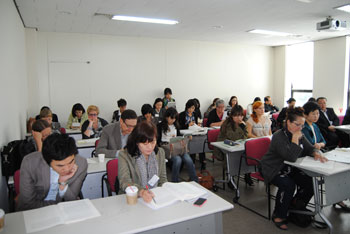
Conference Audience
Keith Newlin, from University of North Carolina at Wilmington, the AIZEN and Pusan National University’s invited guest, gave his plenary talk in English, entitled “American Naturalism and Dramatic Adaptation,” in which he emphasized the connections between naturalism in American theater not only to melodrama, but also to the ideas of Charles Darwin. That afternoon, during a `session presided by Je-Boon Yu, “Post-Darwinian Neo-Naturalist Fiction in America,” Jun Young Lee, Kyong-Soon Chang and Eun Jung Park, respectively, presented papers on John Dos Passos, Joyce Carol Oates and science-fiction in contemporary visual media. The parallel session featured a panel organized and chaired by Juan Pablo Spicer-Escalante on “ Re-semantising Hispanic Naturalism,” in which he, together with Marcos Campillo-Fenoll and Tania Carrasquillo Hernandez touched on a number of as-yet unexplored aspects of Argentine and Puerto-Rican naturalism.The session presided by Julia Przybos, entitled “European Neo-Naturalism,” allowed us to listen to analyses by Pirjo Lyytikäinen, Riikka Rossi, and Jean-Sébastien Macke highlighting twentieth-century developments in naturalism in Finland and France. Finally, Midori Nakamura, Ana Oancea, and Justine Huet gave their papers in a session organized and chaired by Anna Gural-Migdal on filmic aspects of naturalism, especially in contemporary Korean cinema, testifying to the vast influence of naturalist aesthetics.
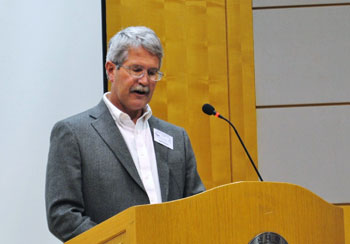
Keith Newlin
Thursday evening, conference participants were invited to Pusan National University President’s Reception, in Hyowon Hall, Sangnam International House. Dean Changsoo Kim, from the PNU Office of International Affairs, hospitably welcomed his guests in a speech. In an elegantly draped banquet room, they were treated to a sumptuous buffet featuring Korean and Japanese specialties, including kim chi, sushi and sashami, and to a concert of ancient Korean music, presented by female musicians in traditional Korean costume deftly plucking zither-like instruments.

Concert of Traditional Korean String Instruments
On Friday, in a session presided by Hélène Poiré, “Representational Techniques in Les Rougon-Macquart,” we listened to Francis Lacoste, Jeremy Worth and Anna Bondarenco, who gave papers on carefully analyzed aspects in novels from Zola’s famous series, such as L’Assommoir or Germinal. In the session chaired by Pirjo Lyytikäinen, “Late Nineteenth- and Early Twentieth-Century Naturalism,” Guri Ellen Barstad, Vasily Tolmatchoff, and Fredrik R. Stark presented their studies on naturalist dimensions in the works of Bjørnstjerne Bjørnson, Oscar Wilde, and Theodore Dreiser. In the session titled “Cultural Approaches to the Zolian Text,” chaired by Marie-Sophie Armstrong, Chantal Morel, Andrea Gogröf-Voorhees and Carolyn Snipes-Hoyt challenged us with re-readings of Les Rougon-Macquart from a historico-cultural angle.
During the plenary session on Friday afternoon, Alain Pagès, pre-eminent Zola and Dreyfus specialist from the Université de Paris III-Sorbonne Nouvelle, the AIZEN and Pusan National University’s honored guest, gave a paper titled “Comment définir le naturalisme?” in order to underscore four essentiel aspects of naturalist writing: the documentary, the polygraphic, the collaborative and the theatrical. Calling into question traditional literary history, which often reduces naturalism to a degraded form of realism, Professor Pagès proposed a re-evaluation of its historical originality. According to Zola himself, “le naturalisme n’est pas une école, au sens étroit du mot, et voilà pourquoi il n’y a pas de chef distinct, parce qu’il laisse le champ libre à toutes les individualités.”

Alain Pagès
And then, in a session presided by Vasily Tolmatchoff and Jeremy Worth, “Re-Thinking Naturalism,” Wang Joo Lee, Simon Kim, Jin-Ho Kang and Aïda Suleymenova put forward challenging comparative studies, revealing for example underlying connections, between Zola and Kim Tong-In, between Russian and Japanese naturalists, or between D.H. Lawrence and Nietzsche, in the sense of a Darwinian struggle for power. To end the day, a penetrating session chaired by Lisa Ng featured “The Reception of Zola and his Influence in Japan,” with papers by Kyoko Watanabe, Akiko Miyagawa, and Miyuki Terashima-Fukuda. These presentations revealed the transformational process the notion of naturalism has undergone in Japan, which resulted in a new literary genre, the “watakushi-shosetsu,” a very personal and autobiographical novel.
On Friday evening, conference participants were amazed by the spectacular view of the City of Pusan by night, during a dinner cruise on the Bay of Pusan, organized to celebrate the 20th anniversary of the AIZEN in a grandiose manner. During the exotic and abundant seafood buffet, everyone raised a glass to toast the AIZEN and its team, recognizing the important role the association has played in furthering research in the area of Zola and Naturalist Studies. Many stood up to give their tributes to the President of the AIZEN, Anna Gural-Migdal, who has inspired and energized its members for more than fifteen years. Researchers from all over the world listened as several gave personal accounts of Anna Gural-Migdal’s devotion, underscoring the fact that she has given herself unconditionally to furthering the goals of the association. At the end of the evening, Jean-Sébastien Macke led out in a celebration in song of Zola and naturalism. All the participants chimed in with the original words and tune to “Je suis naturaliste!” from 1879, which he had researched and prepared for us.
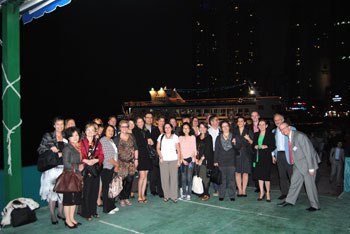
Conference Participants Before Embarking
The final day of the conference featured naturalist film, although a number of other topics were discussed as well. The day began with a session presided by Mihaela Marin, titled “The Naturalist Text as Document/Documentary.” Christian Mbarga, Julia Przybos, Ye Young Chung and Soundous El Kettani, developed historical and documentary perspectives on naturalist novels from the end of the nineteenth century. In the session “Lesser-Known French and Francophone Naturalist Writers,” chaired by Guri Barstad, Jean Anderson, and Marie-Sophie envisaged naturalism as a method, from the angle of two minor naturalist authors. Sébastien Roldan proposed a study of the narrator in a novel by Édouard Rod, from a schopenhauerien perspective, while Rod Cooke presented his analysis of the free indirect style in novels by Céard and Hennique. Then, in a session presided by Rosemary A. Peters, Woosun Kang, Youngjeen Choe and In-Young Nam spoke to “Naturalist Aspects of Asiatic Cinema.” It came out, during this session, that, in the most recent docudrama by Kwon-Taek Im, naturalism is defined in part through the image and its texture. In the third session, chaired by Simon Kim, on “Body Work in the Naturalist Text,” Mihaela Marin, Chiu-Yen Shih, and Hyun-Soo Park broached topics concerning the anatomical, the physiological, and the sexual.
Myong-Hwan Jung, from Seoul National University and the National Academy of Sciences in Korea, was invited by the National University of Pusan, to give the third plenary talk of the conference, titled “Les deux faces d’Émile Zola,” with the objective of returning to a consideration of the development of Zolian naturalism. Then, in a session presided by Jean-Sébastien Macke, Anna Gural-Migdal, Larissa Sloutsky, and Rosemary Peters reflected, through comparative analyses, on “Literary and Cinematic Intersections,” while Haroldo Ceravolo Sereza, Larissa Clachar, and Seongho Yoon focused on the distinction between realism and naturalism in the session titled “Worldwide Naturalism,” chaired by Il-Jae Jo.
The last session of the day was a huge success, thanks to the visit of Kwon-Taek Im, the most famous Korean filmmaker, who won the Prix de la mise en scène at the Festival de Cannes for his film Ivre de femmes et de peinture (2002). He has had a long and succesful career, having created over one hundred films. After the projection of Low Life (2004), Kwon-Taek Im fielded questions from the audience, explaining his directing style, borrowed from the film noir, but also providing his views on naturalism and cinema in relationship to his philosophy of life.
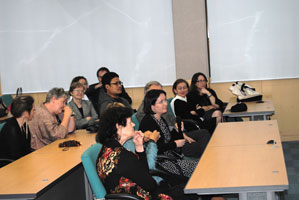
Conference-goers and Director Kwon-Taek Im
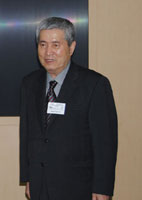
Finally, an invitation to the Pusan International Film Festival “French Night” at the Hotel Novotel Ambassador gave the AIZEN group the opportunity to meet actress Isabelle Huppert. The jury presided by Isabelle Huppert in 2009 at the Festival de Cannes awarded Le Grand Prix to Thirst, a free adaptation of Zola’s Thérèse Raquin by Chan-Wook Park. During the evening’s festivities, prizes were awarded for the Sixteenth Pusan International Film Festival, with Sang Soo Hong, a reputable Korean filmmaker among the recipients. The festivities ended with panache, at a discotheque on the seaside. We would like to thank the Alliance Française de Busan, its director, Mme Aude-Émeline Loriot-Nurbianto, and the Institut Français de Corée du Sud, as well as the Ambassade de France à Séoul, for their support and invitation to this fascinating event.
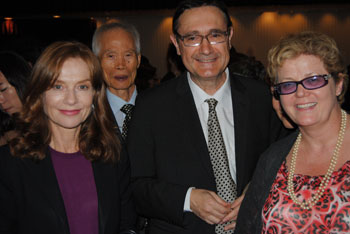
French Actress Isabelle Huppert with Sang-Koo Kim, Alain Pagès, and Anna Gural-Migdal
During the entire conference, writers and filmmakers, with very diverse origins and languages, were rediscovered in the name of naturalism. A number of authors were mentioned, for instance, Edith Wharton, Pierre Magnan, Wakayama Bokusui, and Machado de Assis, as well as several important filmmakers ‒ Ozu Yasujiro, Kwon-Taek Im, Sergei Eisenstein or Christina Comencini. Various processes for the reception, traduction and adaptation of naturalism were described, in very different cultures, attesting to the importance of the influence of naturalism in artistic fields specific to modernity. Yet, all the participants seemed to ponder the same question: “How can the field of naturalism be defined or circumscribed?”
The success of the AIZEN/PNU conference will no doubt result in a new openness for exchanges without borders in Naturalist Studies. In this regard, we are indebted to Alain Pagès, director of the Centre Zola (ITEM-CNRS) in Paris and his collaborator Jean-Sébastien Macke, for their continued support and participation. We are grateful to Chantal Morel for her loyalty to the AIZEN, as one of the founders of the Émile Zola Society London. And we are pleased to have made contact with Yong Ho Choi and Akiko Miyagawa, respectively, of the Société Coréenne de Langue and Littérature Françaises and of the Cercle de Recherches sur le Naturalisme Français in Japan.
To mark the 20th anniversary of the AIZEN, a collection of essays entitled Re-Reading Zola and Worldwide Naturalism : Miscellanies in Honour of Anna Gural-Migdal will be published by Cambridge Scholars Publishing in 2013. Edited by Carolyn Snipes-Hoyt, Marie-Sophie Armstrong and Riikka Rossi, this volume consists of twenty-nine essays that come almost entirely out of the Pusan conference. The major sections of the Table of Contents are as follows: The Zolian Project and Legacy; The Naturalist Text as Document; Representational Techniques in The Rougon-Macquart; Lesser-Known Naturalist Writers; Zola and Naturalism in Asia; and Worldwide Naturalism and Neo-Naturalism. Beginning with Zola’s initial writing projects and vision and ending with the expansion of his ideas to many countries of the world and, in time, to the present day in recent genres, the content of this volume offers innovative insights into areas of Zola and Naturalist Studies encouraged by the AIZEN over its twenty-year existence.
The 2014 AIZEN/UNO International Conference in New Orleans, Louisiana
We are now looking forward to the next conference, which will take place at the University of New Orleans (USA), to be held from March 6-8 of 2014. The state of Louisiana is one of those crossroads locations where many cultures intersect, not the least of which is French. Louisiana’s francophone heritage consists of an exciting mix of French, Spanish, Caribbean, and native traditions to create a cultural “gumbo” rich with many flavors. At the mouth of the Mississippi River, New Orleans has been an important port city, the gateway to the Bayou country and plantations of long ago, and the focal point of a vibrant culinary tradition. New Orleans is within easy reach of the stomping grounds of famed Southern writers, such as John Kennedy O’Toole, Anne Rice, and Walker Percy ‒ and, when considering a wider radius, the list includes Kate Chopin and William Faulkner, Tennessee Williams, and FlanneryO’Connor.The French explorer Robert Cavelier de La Salle named the region Louisiana to honor France's King Louis XIV in 1682. The first permanent settlement, Fort Maurepas was founded by Pierre Le Moyne d’Iberville, a French military officer from Canada, in 1699. The French colony of Louisiana originally claimed all the land on both sides of the Mississippi River and north to French territory in Canada. Over time, planters developed large plantations and built fine homes, a pattern repeated in New Orleans and other places.
Except for the area around New Orleans and the parishes around Lake Pontchartrain, Louisiana became a possession of Spain after the Seven Years’ War by the Treaty of Paris of 1763. Nevertheless, the pace of francophone immigration to the territory increased swiftly, due to another significant aftereffect of the French and Indian War. Several thousand French-speaking refugees from the region of Acadia ‒ now Nova Scotia, Canada ‒ made their way to Louisiana after being expelled from their home territory by the newly ascendant British. The first group of around 200 arrived in 1765. They settled chiefly in the southwestern Louisiana region and their descendants came to be called Cajuns.
As a result of the Haitian Revolution, Bonaparte gave up his dreams of an American empire and sold the Louisiana Territory to the United States, which subsequently divided it into two territories: the Territory of Orleans, which became the state of Louisiana in 1812, and the district of Louisiana. Another result of the Haitian Revolution was that a major emigration of refugees flowed into Louisiana, settling chiefly in New Orleans. The thousands of Haitian immigrants included many free people of color and whites, enlarging the French-speaking community.
You will need to visit New Orleans and Louisiana to gain a sense of the last 200 years in this area’s cultural landscape and its claim to fame ‒ Mardi Gras, Creole and Cajun cuisine, jazz and, in general, the unique cultural mix that has developed.
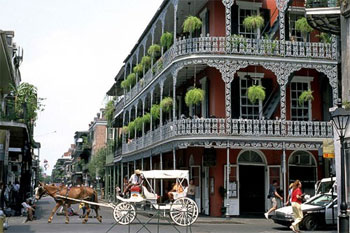
French Quarter Street scene in New Orleans
The conference sessions will be held at the University of New Orleans, a metropolitan campus of the University of Louisiana System. Opening in 1958 on the shores of beautiful Lake Pontchartrain, the University of New Orleans was the first racially integrated public university in the South. Today a major research institution of 11,000 students, it boasts a top-30 film school, a world-renowned Jazz Studies program, the Midlo Center for New Orleans Studies, the Alexis de Tocqueville Project, and unique programs in Urban Studies, Women’s Studies, Romance Languages, and Interdisciplinary Studies, just to name a few. UNO suffered extensive damage due to Hurricane Katrina, but quickly resumed classes 42 days after the storm – a unique feat among area institutions during the fall of 2005. The university and its fascinating city present a lesson in resilience and an ideal location for those interested in studying naturalism as an exploration of the interrelationships between art and social justice. The AIZEN is pleased to be collaborating with Juliana Starr, Associate Professor of French and and Co-organizer of this conference. We thank Eliza Ghil, Chair of the Department of Foreign Languages, for her support and collaboration, and Susan Krantz, Dean of the College of Liberal Arts, who has kindly offered the rooms at the University of New Orleans for the conference sessions.

University of New Orleans
The sessions of the conference will feature several disciplines with Zola and naturalism as their focus, that is, on history, literature, the fine arts, and film, many of which take into account the location of the conference in the USA, with a few focusing specifically on the South or on the unique cultural situation of Louisiana.
Sessions offered specifically on Zola include his involvement in Naturalist Theater and the Medan Group, Le Roman expérimental, and the impact of J’accuse in America. There will be a focus on American Naturalist authors, from the North and South, male and female, such as Frank Norris, Theodore Dreiser, Jack London, Willa Cather, Edith Wharton, or Kate Chopin. There will be opportunities to give papers on more local American Creole writers, such as Alfred Mercier, Sidonie de la Houssaye, Georges Dessommes, and George Washington Cable. Since New Orleans has always had a strong connection to the Caribbean and Africa, there will be a session featuring various Carribean and African naturalisms. A special session has been proposed on connections between Zola and the Ashcan School of Painting in the US. There will also be a session on the sublime in naturalist aesthetics, one on American naturalist film, and yet another on naturalism and neo-naturalism in Austrian literature and film. This latter is particularly important for this conference, since The University of New Orleans has a Center Austria, for Austrian and European Studies in the Gulf South.
One of our guest speakers is Karl Zieger, Professor of comparative literature at the Université Charles de Gaulle-Lille 3 (France) and associated with the Centre de Recherche sur Zola et le Naturalisme CNRS-ITEM. His major area of specialization is cultural transfer between France and Germany and between France and Austria, during the 19th and 20th centuries, with an emphasis on naturalism. He authored Die Aufnahme der Werke von Emile Zola durch die österreichische Literaturkritik der Jahrhundertwende (Peter Lang, 1986). Notably, he translated and edited, together with the author of the original work in French, Alain Pagès, Emile Zola ‒ Die Dreyfus-Affäre: Artikel, Interviews, Briefe (Haymon-Verlag, 1998), completing this work with German and Austrian documents related to the Dreyfus Affair and writing the preface: “Zola und die Dreyfus-Affäre in den deutschsprachigen Zeitungen.” Karl Zieger has also edited a number of collective works, for example, on Zola’s “J’accuse…!” and naturalist theater. Recently he has published a book on one of the most important naturalist writers in Austria, Arthur Schnitzler et la France 1894-1938. Enquête sur une réception (Presses Universitaires du Septentrion, 2012).
And, from the US, we have invited Donna M. Campbell, Associate Professor of English from Washington State University (USA), who specializes in nineteenth- and early twentieth-century American literature. Previously, at Gonzaga University, she won the university's Outstanding Scholarship award in 2000. Her book Resisting Regionalism: Gender and Naturalism in American Fiction, 1880-1915 (Ohio University Press, 1997), won the Northeast Modern Language Association book prize in 1995. Selected recent publications include “Literary Darwinism and the Rise of Naturalism” in The Cambridge History of the American Novel, ed. Leonard Cassuto and Clare Eby (2011); “Women and Naturalism” in The Oxford Handbook of American Naturalism, ed. Keith Newlin (2011); “At Fault: Kate Chopin’s Other Novel” in The Cambridge Companion to Kate Chopin, ed. Janet Beer (2008); and “Naturalism: Turn-of-the-Century Modernism” in The Blackwell Companion to the American Novel, 1900-1950, ed. John T. Matthews (2009). Her publications also include work on Edith Wharton, Frank Norris, Theodore Dreiser, and Jack London, among other American writers. Her current project is a book on women writers of naturalism called Bitter Tastes: Naturalism, Early Cinema, and American Women's Writing.
During the New Orleans conference, there will be special events featuring the artistic genres of photography, music, and film, to showcase the University of New Orleans’s strengths in these areas and for the enjoyment of conference participants. At Juliana Starr’s instigation, there will be a show of naturalist photos, entitled “Southern Women at Work,” in conjunction with Women’s History Month and co-sponsored by Women’s and Gender Studies program at UNO. During the opening reception of the conference, on Thursday evening, March 6, 2014, prizes will be awarded for the entries for the exhibit at the University of New Orleans Art Gallery, and a student jazz ensemble will perform.

UNO Art Gallery Exhibit: Southern Women at Work
All participants are invited to bring books, Call for Papers, recent publications in order to have them exhibited in the lobby of the Performing Arts Center, where all the conference sessions and keynote speakers’ presentations will be held. The name of the exhibit Professor Starr plans to organize is “Naturalism illustrated” and will feature naturalist book illustrations and their creators.
The next evening, Friday, the Naturalist Film Festival will be held in the Performing Arts Center Theater, during which participants will view Low and Behold (2007) directed by Zack Godshall. Based on real events, this film tells the story of Turner Stull (Barlow Jacobs), a young insurance claims adjuster in Post-Katrina New Orleans who risks his job to help a local man, Nixon (Eddie Rouse), find his lost dog. As this unlikely pair traverses the city, Turner comes to discover that some damage is immeasurable. Filmed on location in New Orleans only months after Hurricane Katrina, Low and Behold blurs the line between reality and fiction, creating a mosaic of images, faces, and voices that together make for a unique cinematic experience. The screening will be followed by a discussion with the director, Zack Godshall, the 2009 Louisiana Filmmaker of the Year.

Low and Behold (2007), directed by Zack Godshall
On Saturday evening, participants will enjoy a dinner cruise on board a vintage paddle wheel steamer on the Mississippi. The boat dock is easy walking distance from any downtown or French Quarter hotel. It’s very near Café du Monde, famous for its beignets ‒ on the Mississippi in the French Quarter. The cruise leaves at 6:00 p.m. and returns at 9:00 p.m. On board, participants will enjoy a buffet dinner featuring local specialties and the sounds of a grammy-nominated live jazz band. In addition to the jazz concert and dinner, those on board will be able to explore the workings of the boat and take in the sights along the Mississippi.
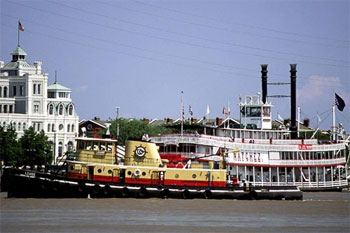
The Steamboat Natchez on the Mississipi River
Conference-goers are encouraged to stay at Hampton Inn Downtown, which is located near the French Quarter and is only a 30-minute bus ride ($1.25 US per trip) to or from the University of New Orleans, where the sessions will be held. The bus you will need is the #55 Elysian Fields, a direct line to the UNO. From a location just a few blocks from the hotel, this bus departs twice every hour, Monday-Friday (and once every hour on Saturdays). The trip takes 30 minutes and affords a very pleasant ride through the French Quarter and Gentilly. You will also be able to return to the hotel on the same bus line.

The Hampton Inn Downtown, New Orleans
The AIZEN has blocked 40 rooms with two double beds at Hampton Inn Downtown at the special rate of $159.00 US per night plus tax, with a daily hot breakfast buffet included, from March 5, departing on the 10th. To get the special conference rate when you make your reservation, just give the person you speak to the name of AIZEN (coded AIZ in the reservations computer). Here are the coordinates for this hotel :
Telephone : 1- 504-529-9990 or 1-800-292-0653 (toll free)
Address : Hampton Inn Downtown, 226 Carondelet Street, New Orleans LA, 70130, USA
Reservations can also be made by visiting : http://www.neworleanshamptoninns.com
The hotel has no restaurant. There are, however a few restaurants within easy walking distance : Red Fish Grill, Olivier’s Creole Restaurant, and Acme Oyster House.
All reservations must be guaranteed with a major credit card and must be made no later than February 3, 2014. There will be no penalty for cancellations made 14 days or more prior to arrival, for those having booked as part of the AIZEN block during the conference dates, March 5-10, 2014. If conference participants would like to stay on at Hampton Inn Downtown beyond the conference dates (that is, past the night of the 9th of March), the rate would be $229.00 US per night plus tax, through the 17th of March.
The MSY-Louis Armstrong New Orleans International Airport is 18.6 km/11.5 miles away. Conference participants will be able to get a shuttle to and from the airport. The round-trip costs $38.00 US and can be reserved at: http://www.airportshuttleneworleans.com
It is best to reserve before the trip and print out the tickets before you go to the conference. This shuttle is very reliable and half the price of a taxi.
If you wish to reserve a room at Hampton Inn Downtown for a few days before the conference, so that you can experience Mardi Gras in New Orleans firsthand, there are very specific requirements. You may book as much as one year in advance – and are encouraged to do so at your earliest convenience, after March 1, 2013. During Mardi Gras, the rooms will be more expensive ($289.00 US per night plus tax) and much more in demand; therefore, you will need to book for a minimum of 5 nights, starting on the 28th of February. There is also a 30-day cancellation policy for rooms booked during this event.
You may also try to find a less expensive hotel for the Mardi Gras period, but you will still need to reserve months in advance and up to one year. In 2014, the actual day of Shrove or Fat Tuesday will be March 4. Mardi Gras is a statutory holiday in Louisiana and that is the day of the main parade. But the activities will begin on March 1 and continue through Tuesday, the 4th, the day of the parade. The day after is Ash Wednesday, March 5. If you are unable to attend the Carnival celebrations, you will nevertheless want to visit at least one of the Mardi Gras museums in New Orleans, such as The Backstreet Cultural Museum, Blaine Kern`s Mardi Gras World, or The Presbytère.

Mardi Gras Float and Crowd in New Orleans
Milestones and Achievements for AIZEN members
It is with great sadness that we report the passing in April of 2011 of Gilbert Darbouze, a faithful member of the AIZEN since its beginnings. Professor of Languages and Cultures at Bloomsburg University in Pennsylvania (USA), he specialized in Hispanic and Francophone naturalisms in literature and film, challenging AIZEN members with his papers on a number of very original topics. He published a book with Peter Lang in 1997: Dégénérescence et Régénérescence dans l’œuvre d’Émile Zola et celle de Manuel Zeno Gandia. At the AIZEN Conference in Rio de Janeiro in 2004, he made a presentation in a plenary session based on his breaking research undertaken at the Bibliothèque nationale de France. This paper revealed details of a correspondance between Brazilian writer João Marquès de Carvalho and Émile Zola. Gilbert will be fondly remembered by AIZEN members for his erudition, sense of humour, musical talent, incredible memory, in particular for passages from French plays and Les Fables by La Fontaine, and his kind and friendly spirit.

Gilbert Darbouze
Another one of our members, Debbie L. López, Associate Professor of English at the University of Texas at San Antonio, passed away on October 14, 2011, after an extended illness. Specializing in nineteenth-century literature in both the US and England, she earned her doctorate from Harvard University, where her dissertation received the Howard Mumford Jones Prize. The papers she presented at AIZEN conferences dealt with American naturalist author Jack London. In 2002, she was an important part of the organizational committee for the AIZEN International Conference held at her university. Those of us who worked with her or met her, at the conferences held in Jaén, Spain, or San Antonio, can say that she was truly a gracious, sensitive person with a deep love of literature, choosing the most opaque of texts and impressively probing their possible meanings. In 2008-2009, she was a Visiting Fullbright Scholar at Aristotle University, Thessaloniki, Greece, teaching courses in American literature. She will be missed by all.
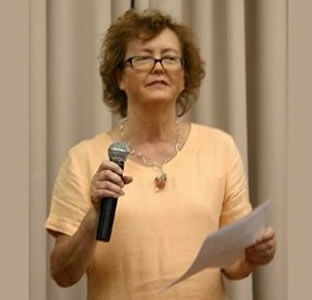
Debbie L. López
We have an abundance of good news to report concerning our members. Congratulations to Midori Nakamura who has successfully defended her doctoral thesis dealing with the function of “l’annonce” in Zola’s works at the Université de Paris III-Sorbonne Nouvelle, under the direction of Alain Pagès; and to Haroldo Ceravolo Sereza, who has also successfully defended his doctoral thesis on Machado de Assis and the problem of realism-naturalism in Brazil, at the University of São Paulo.
Best wishes to Juan Pablo Spicer-Escalante, who has been promoted to Full Professor at Utah State University (USA), and to Jennifer Wolter, who has a new position in French in the Modern Languages and Classical Studies Department at Bowling Green State University, in Ohio (USA). Cheers to Justine Huet, who now has a position as an Assistant Professor at Mount Royal University in Calgary (Canada); and to Mélanie Giraud, who also has a new position, as a Lecturer of French, at the University of Central Arkansas.
Our congratulations go to Aurélie Barjonet, who is a Maître de Conférences at the Université de Versailles-St-Quentain-en-Yvelines (France). Her book, Zola d’Ouest en Est. Le Naturalisme en France et dans les deux Allemagnes, came out in November of 2010 (Presses Universitaires de Rennes). It deals with the post-World War II fortune of Zola’s novels, specifically in the two Germanies – their translation and reception in two very different political climates.
Hats off to Julia Przybos, a Professor of French at Hunter College, since she has been named Director of the Ph.D. Program in French at the Graduate Center, CUNY. She has also come out with a book entitled Les Aventures du corps masculin (José Corti, 2012). The work focuses on lesser-known 19th-century writers, who reveal in no uncertain terms the contemporary obsession with physiological urges – appetites for food and sex ‒ while better-known and more successful writers, for example, Balzac or Zola, code these desires and behaviors within descriptions of contemporary social structures. This study offers a grid for reading these narratives which explore the nineteenth-century bodily existence of men.
Cheers to Robert Ziegler, who has also published a book, entitled Satanism, Magic, and Mysticism in Fin-de-siècle France with Palgrave Macmillan (2012). In his study, Professor Ziegler explores how, in response to the spread of Republicanism and science, turn-of-the-century France witnessed a powerful movement toward mysticism, magic, and devil worship; in this regard, Catholics increasingly adopted a form of mysticism based on a belief in the redemptive power of suffering and a hope for the coming apocalypse.
Kudos to Elizabeth Emery, whose book, titled Photojournalism and the Origins of the French Writer House Museum (1881-1914): Privacy, Publicity, and Personality, has come out with Ashgate Press (2012). This work provides an overview of the social forces that brought writers’ homes to the forefront of the French imagination at the end of the nineteenth century and the beginning of the twentieth. This study analyzes representations of the apartments and houses of writers such as Zola, arguing that the writer's home became a contested space and an important part of the French patrimony at this time.
Congratulations to Éléonore Reverzy, who, together with Romuald Fonkoua and Pierre Hartmann, has edited a collection of essays entitled Les Fables du politique des Lumières à nos jours: Hommage à Jean-Paul Schneider (Presses de l’Université de Strasbourg, 2012). Reverzy wrote the preface to this work which explores the role of narratives, polyphonic or monologic, in shaping and promulgating laws of power and authority. The essays deal with the works of various authors, including Zola’s Son Excellence Eugène Rougon.
Sébastien Roldan, currently completing his doctoral thesis at the Université du Québec à Montréal and the Université de Paris Ouest Nanterre, has been awarded a prize, in the competition “Chercheurs auteurs de la relève,” for his manuscript published in 2012, with Presses de l’Université du Québec. We join with the jury, in congratulating him on his book, entitled Le Pyramide des souffrances dans La Joie vivre d’Émile Zola, which pursues the philosophical meanings behind Zola’s novel.
Two more of our members, Riikka Rossi and Pirjo Lyytikäinen, deserve recognition. Along with four other editors, they have come out with a collection of essays, entitled Rethinking Mimesis: Concepts and Practices of Literary Representation (Cambridge Scholars Publishing, 2012). They have each also contributed an essay to this volume which deals with various aspects of the concept of mimesis throughout history, exploring the ways in which literature produces reality effects and negotiates its relationship to the real world and/or its ideologies and bringing this age-old notion up-to-date with analyses of more recent texts.
Last but not least, we are pleased to announce that Anna Gural-Migdal, President of the AIZEN, has published a book, entitled L’Écrit-Écran des Rougon-Macquart. Conceptions iconiques et filmiques du roman chez Zola, with Presses Universitaire du Septentrion (2012). In this work, she sets forth her exploration and theorization of the iconic nature of Zolaʼs narrative style and sheds light on its anticipatory effect and transfer into the new medium of film. In his review of the book, that will appear in Les Cahiers Octave Mirbeau, No 20 (2013), Yannick Lemarié concludes:
Si l’auteur montre effectivement une conception iconique et filmique dans l’œuvre du romancier, elle ne cherche pas à replier un art sur un autre. Sage précaution, qui ne donne que plus de valeur et de puissance au travail d’élucidation qui a été mené et à un livre qui est appelé à devenir une référence incontournable.

With these announcements, we would like to remind you that Valerie Minogue, President of the Emile Zola Society London (UK), and Chantal Morel, Secretary of that association, are organizing a conference to be held on October 18 and 19, 2013, at the University of Notre Dame, in central London, with the support of that university, Birbeck College, and the Institut Français du Royaume-Uni. The title of the interdisciplinary conference is Repenser le Réel – La Fiction, l’Art et le Théâtre au temps d’Émile Zola/ Rethinking the Real Fiction, Art and Theatre in the Time of Émile Zola. Please access the Emile Zola Society’s web site for more information: http://www.emilezolasocietylondon.org.uk
The organizers have extended the deadline for submission of abstracts until the end of February, 2013. Please use the email address 2013zola@gmai.com for all communication concerning this conference.
Congratulations to Jean-Sébastien Macke, who has a new position at le Centre Zola (ITEM-CNRS), where he is digitalizing Les Cahiers naturalistes for the years leading up to 2000. Alain Pagès, Editor-in-Chief of Les Cahiers naturalistes, and Jean-Sébastien Macke deserve a round of applause, since they have recently completed a major collaborative project: ArchiZ. Here is what Alain Pagès says about the project and its development:
Le programme ArchiZ
L’« équipe Zola » (Céline Grenaud, Sophie Guermès, Chantal Pierre, Olivier Lumbroso, Jean-Michel Pottier et Jean-Sébastien Macke), dirigée par Alain Pagès, vient d’obtenir de l’ANR (Agence Nationale pour la Recherche) un soutien financier qui va lui permettre de développer, au cours des quatre années à venir (2012-2015), un programme de recherche intitulé ArchiZ (« Archives zoliennes »). Ce programme repose sur l’association de trois partenaires: l’université de la Sorbonne nouvelle-Paris 3, l’Institut des Textes et Manuscrits modernes (CNRS), et le Département des Manuscrits de la Bibliothèque nationale de France. Il a pour objectif de présenter une réinterprétation des archives qui peuvent aujourd’hui être rassemblées autour de l’œuvre d’Emile Zola. Il se propose d’entreprendre une lecture génétique de ces archives qui permette d’apporter une réponse aux problèmes posés par leur classement, en offrant une nouvelle vision de l’auteur des Rougon-Macquart et de l’auteur de « J’accuse ». Trois catégories d’archives seront prises en compte: des archives imprimées (l’œuvre de l’écrivain et les textes critiques qui la commentent); des archives manuscrites (les manuscrits et les dossiers préparatoires des romans, conservés à la BnF) ; et des archives iconographiques (l’iconographie liée à l’œuvre romanesque et à l’affaire Dreyfus).
Sur le plan scientifique ce programme de recherche souhaite appliquer à l’ensemble des archives zoliennes les hypothèses de la critique génétique: à partir des archives manuscrites, il proposera de mettre en œuvre une « génétique du cycle » qui soit capable d’analyser la dynamique interne des dossiers préparatoires des Rougon-Macquart; et, d’une manière parallèle, en interrogeant la diversité des archives imprimées et des archives iconographiques, il proposera une « génétique de la réception » qui s’efforcera de relier entre elles les problématiques de la genèse et de la réception.
Ce qui sera privilégié, c’est une approche de l’œuvre de Zola qui ne soit pas purement philologique, mais puisse déboucher sur une « génétique culturelle » explorant, dans le contenu des dossiers préparatoires, les traces des présupposés du discours collectif, les liens de filiation et de dépendance entre ce discours et le soliloque initial de l’écrivain. De la même façon, il s’agira, en se tournant du côté de la réception, de percevoir dans leur évolution historique la diversité des jugements de la critique littéraire pour comprendre comment celle-ci a perçu les mécanismes de l’écriture zolienne, amenant le romancier à repenser les cadres de son esthétique.
Ces hypothèses scientifiques trouveront leur aboutissement dans la réalisation d’un site Internet qui offrira une vision synthétique de l’ensemble des archives zoliennes actuellement disponibles. Dans sa première phase, il comprendra cinq parties distinctes: l’ensemble des Rougon-Macquart associé à un puissant moteur de recherche; une iconothèque riche de plusieurs milliers d’images (photographies, caricatures, illustrations, affiches…); les dossiers préparatoires numérisés par la BnF; les Cahiers naturalistes (1955-2000) en accès libre; la bibliographie zolienne de David Baguley. Ces cinq outils seront eux-mêmes reliés entre eux, permettant ainsi une exploration transversale de l’archive zolienne. Le site sera, par ailleurs, enrichi progressivement de fiches synthétiques consacrées aux grandes questions de la vie et de l’œuvre de Zola ainsi que de fiches pédagogiques en lien avec les programmes de l’enseignement primaire et secondaire.
Des journées d’étude et un colloque final accompagneront ce travail de recherche.
Alain PAGÈS
Directeur du Centre Zola Jean-Sébastien MACKE (Secrétaire scientifique du programme ArchiZ)
Finally, we have some announcements about the AIZEN. The review Excavatio is in the process of digitalization. That is, the journal that was hard copy before, will henceforth be published electronically. Another facet of the modernization of the AIZEN is that we now have a Facebook page: http://www.facebook.com/pages/AIZEN/247656841953965
This page is maintained by Rosemary Peters, Jeremy Worth, and Justine Huet. Our presence on Facebook will make us more accessible to interested persons all over the world and we will be capable of quickly posting announcements. If you have information you would like to communicate to AIZEN members, concerning your activities as a member of the AIZEN, please contact Rosemary Peters (romaryka@post.harvard.edu), Jeremy Worth (jworth@uwindsor.ca), or Justine Huet (jhuet@ualberta.ca). Furthermore, in 2013 all AIZEN members will be able to renew their memberships easily on-line and to pay their dues using Paypal.
We are looking forward to meeting all of you in New Orleans and wish you a Happy New Year!
Anna Gural-Migdal and Carolyn Snipes-Hoyt, December 29, 2012
Tributes to the AIZEN, on the Occasion of its 20th Anniversary Celebration

Carolyn Snipes-Hoyt, Opening Speech
Opening Speech
This year the AIZEN is celebrating twenty years of existence. The International Association for Multidisciplinary Approaches and Comparative Studies related to Émile Zola and his Time, Naturalism, Naturalist Writers and Artists, and Naturalism in the Cinema around the World was founded by Monique Fol in 1991 and, after her passing, Anna Gural-Migdal became the president. The main purpose of this scholarly society has been to provide a forum for the worldwide expansion and promotion of Zola and Naturalist Studies. So far 16 international conferences have been held, including this one in Pusan, to accomplish this goal, where internationally recognized specialists, senior and junior professors have come from the four corners of the earth, new and independent scholars, doctoral candidates and other individuals interested in making the results of their research known.
Since 1991, when the First International AIZEN Conference took place in Boston, Alain Pagès, renowned French specialist in the areas of Zola and Naturalism, and now professor at the Université de Paris III-Sorbonne Nouvelle, has endorsed our undertaking. We are pleased to have Professor Pagès join us in Pusan to celebrate the AIZEN’s twentieth anniversary. Since its inception, approximately 1,000 members have attended the AIZEN conferences, contributing their research and insights in the areas of literature, film, comparative studies, and the fine arts. In addition, through our international conferences we have been able to discover and enable new talent to surface. The AIZEN Award (renamed Schor/Cahm Award in 2002) for the best paper given by a doctoral candidate was created in 1995. Two of these are with us to pay homage to the AIZEN – Rosemary Peters and Mihaela Marin. Moreover, our project has emphasized unique North American interdisciplinary approaches to criticism, which, back in 1992, Alain Pagès termed “tout à fait fécond... peu développé en Europe... demand[ant] de l’audace et une certaine forme d’irrévérence” (Alain Pagès, “Avant-propos,” Excavatio, vol. 1, May 1992).
The present AIZEN executive, consisting of Anna Gural-Migdal as President, Robert Singer as Vice-President, and myself as Secretary-Treasurer, has not changed since 1999, a situation that has given our association continuity and stability. From the beginning it has also benefitted from the endorsement and collaboration of other associations such as: the Société littéraire des amis d’Émile Zola (France), le Centre de Recherche sur Zola et le Naturalisme (CNRS-ITEM) in Paris, represented by Alain Pagès and Jean-Sébastien Macke, who are present at this conference; and The Emile Zola Society London (England), with one of its founders, Chantal Morel, honoring the AIZEN on many occasions by her enthusiastic participation in AIZEN activities, the Pusan conference included.
During the last twenty years, AIZEN conferences have attracted close to one thousand participants. These events have taken place in seven different countries and fourteen cities in North and South America, Europe, and now Asia. The French Embassy has often sent delegates to show an interest in and support of our project. At Pusan, we have had the pleasure of collaborating with the Director of the Alliance Française, Madame Aude-Emeline Loriot Nurbianto, for whose generosity we are grateful.
The AIZEN has enjoyed, during these twenty years, the privilege of welcoming an impressive list of well-known scholars and prestigious guests. Brigitte Émile-Zola, great-granddaughter of the author has manifested unswerving loyalty to the AIZEN and honored a number of conferences with her presence: San Francisco, New York, Edmonton, and Jaén. Famous specialists in Zola and Naturalism who have collaborated with the AIZEN are Alain Pagès, Colette Becker, David Baguley, Jacques Dubois, Jean-Louis Cabanès, Halina Suwala, and Naomi Schor, who died in 2001. In the field of Naturalism and Comparative Literatures, we have welcomed renowned specialists Yves Chevrel and Carlos Reis. It has been our privilege to listen to some of the most famous specialists in the field of American Naturalism, Jeanne Campbell Reesman, Jacqueline Tavernier-Courbin and, most recently, Keith Newlin. We should not neglect to mention that the AIZEN has hosted some of the best-known professors in the area of Naturalist Cinema, Tony Williams, for example. We give homage to renowned specialist and historian of the Dreyfus Affair, Eric Cahm, who frequented a number of our conferences and left us in 2002. Finally, we should mention the presence of journalists, such as Richard Boston from England and Robert Walenciak from Poland, American Art Critic Richard Bretell, and filmmakers, Larry Cohen, George Romero, and Kwon-Taek Im here in Pusan.
Even though there has been continuity in the organization of the AIZEN conferences, each one has been different based on the place where it was held, the local organizational committee who prepared for our arrival, and the emphasis placed on certain themes in the establishing of sessions. The largest and longest conference was held in Rio de Janeiro, Brazil, with more than one hundred participants and sessions and activities lasting five days. The conference that drew the most media attention took place in Jaén, Spain, commemorating the centenary of Zola’s death. The conference which attracted the largest audiences was no doubt the first one in New York City, where locals came in droves to attend the sessions. The conference for which we received the most support from sponsors was the one in Edmonton, at the University of Alberta, in Canada. The two conferences where we broke the most new ground were the second one in New York City, on film, and the one in Helsinki, on the realist and naturalist “construction” of female figures in Scandinavian and French literature. The two most original conferences venues were early on – one took place on a yacht, the “Ship of Fools,” in San Diego harbor and the other by a swimming pool in Las Vegas. We no doubt danced the most in Glasgow. And the most glamorous conference was in Los Angeles, where filmmaker Larry Cohen arrived in a limousine. The most comfortable and luxurious accommodations were in San Antonio. The most beautiful setting was, arguably, the hilltop campus in San Francisco and the cafeteria food there was the most exquisite, prepared by students at the school of culinary arts. The Philadelphia conference was marked by the sadness and tragedy of 9/11.
Like archaeologists, and thanks to the international scholarly journal Excavatio sponsored by the AIZEN, we have “excavated” Zolian and naturalist terrains in order to rediscover forgotten works, lost paths, and voices neglected by the critics. The major areas covered by the contents of this journal have been, on the one hand, the influence of Zolian naturalism on literature in many parts of the world, and on the other, relations between the former and the visual arts, specifically painting and film. We will publish a special volume of collected essays by 2013 that will commemorate our twenty years of research in the areas of Zola and Naturalism. Amongst those present at the twentieth anniversary celebration are Anna Gural-Migdal, Editor-in-Chief of Excavatio and, serving as Associate Editors, Marie-Sophie Armstrong and myself.
In particular, we propose a toast to Anna Gural-Migdal, who has played the major role in the AIZEN from its inception and who has carried the torch, as its President, for twelve years. Although she has always found herself surrounded by a supportive team and many colleagues, such as Sang-Koo Kim, have invited the AIZEN to hold a conference in their universities, she is the visionary and the one who directs its activities. As a result of her unflagging efforts during many years the AIZEN has become what it is today. She has shown superhuman energy and tenaciousness in accomplishing the mission Monique Fol entrusted her with before her passing.
Anna Gural-Migdal has organized an AIZEN conference almost every year, published books, articles, and Excavatio, about ten thousand pages on Zola and naturalism, accomplished miracles in order to keep our non-profit organization not only afloat but alive and well. She has also overseen the updating of the AIZEN web site, in order to showcase our vision and activities. Furthermore, she has unconditionally supported members of our association, and especially young researchers, encouraging them to participate in AIZEN conferences and assisting them in their search for positions and promotions. Many of those present today attest to the support offered them through the years.
I would like to thank Anna for inviting me to become part of the Executive Committee of the AIZEN and for constantly asking my opinion about decisions to be made and projects to be undertaken. She is truly the motor that drives the AIZEN. Thanks to her contagious energy and her constant need for new challenges, this association has moved forward. It has been my pleasure to work with her, whether at her home, via internet, or in a number of places all over the world that we have visited together. Anna has the capacity to work anywhere and everywhere, even in the middle of the desert. She truly is the inspiration and the impetus behind all of the AIZEN’s activities, not the least of which is the extraordinary strength and breadth of her scholarly expertise that she brings to all aspects of her work. I appreciate her as a scholar, as a visionary, as an organizational genius – and as a friend, in the noblest sense of the word. I think I speak for all of us when I say thank you for everything, Anna.
Carolyn Snipes-Hoyt, Pacific Union College, USA

Alain Pagès, Tribute to the AIZEN
Explorer l’espace littéraire du naturalisme: les vingt ans de l’AIZEN
Monique Fol a fondé l’AIZEN, il y a vingt ans exactement. Le sigle qu’elle a créé pour désigner l’association qu’elle fondait définit un programme de recherche: celui d’études à la fois comparatistes et multidisciplinaires portant sur Zola et son époque, sur le naturalisme, sur les écrivains et les artistes naturalistes dans le monde entier. Ce sigle contracte en quelques lettres une ambition immense. Il se compose de quelques lettres qui font écho au nom de ZOLA. Comme dans “ZOLA” on y retrouve, associées, les lettres A et Z, comme s’il s’agissait de dire que ce que l’on va embrasser doit comprendre la totalité du savoir, du début à la fin de l’alphabet, de A jusqu’à Z…. ZOLA, c’est un sigle, d’une certaine façon, qui fait écho à celui de l’AIZEN. Au-delà de l’œuvre d’un écrivain particulier, c’est le message d’une œuvre, une certaine vision de la littérature qui s’adresse à l’universel, en dépassant les frontières de la littérature française.
Les colloques de l’AIZEN qui se sont succédés depuis une vingtaine d’années sur tous les continents, en Amérique du Nord et en Amérique du Sud, en Europe, et aujourd’hui en Asie – avec ce colloque qui se tient en Corée du Sud –, ont su illustrer pleinement ce message d’universalité qui repose sur la comparaison entre les littératures, l’effort pour saisir ce qui les rapproche, en valorisant en même temps leurs particularités (sinon, il n’y aurait pas de véritable réflexion comparatiste). Ils ont su également franchir la frontière des genres, passer du roman au théâtre, ou envisager le rapport entre le roman et le cinéma. Tous les colloques de l’AIZEN comportent une session, d’une grande richesse, consacrée au cinéma naturaliste – ce dont témoignent notamment les travaux de l’actuelle présidente de l’AIZEN, Anna Gural-Migdal, et du vice-président de l’association, Robert Singer.
Le sigle de l’AIZEN comporte en son centre la lettre “ Z “ qui renvoie au nom de Zola… Zola est au cœur de ce programme de recherche, bien entendu. Mais la dernière lettre du sigle est tout aussi importante : “N”, c’est-à-dire le naturalisme. Ce terme de naturalisme, Monique Fol l’a retenu d’une manière exclusive, alors qu’elle aurait pu choisir également le terme de “réalisme” et relier les deux mots, en parlant de “réalisme et de naturalisme”, comme le font couramment les histoires littéraires (en France notamment) lorsqu’elles parlent de l’époque “réaliste et naturaliste”. Au fond, dans l’ambition qui était la sienne, Monique Fol aurait dû, en toute logique, étendre son programme à l’ensemble du réalisme et du naturalisme, beaucoup plus vaste, a priori, que celui du seul naturalisme. Un tel choix aurait offert un champ plus large encore à l’association qu’elle fondait. Mais elle ne l’a pas fait. Elle a exclu du sigle de l’AIZEN le terme de “ réalisme”. Pas de lettre “R” dans le sigle de l’AIZEN.
Pourquoi cette exclusion du “réalisme”? Pour une raison fondamentale, qui n’avait pas échappé à la fondatrice de l’AIZEN. Lorsqu’on réunit dans une même expression les deux termes de réalisme et de naturalisme, forcément on subordonne le naturalisme au réalisme. Dans une telle perspective, le naturalisme n’est que le prolongement du réalisme, considéré comme le mouvement qui a occupé l’ensemble du XIXe siècle. Le naturalisme est perçu alors comme un aboutissement du réalisme dans la seconde moitié du siècle, et, diront certains, une impasse, un cul-de-sac. Si le réalisme a commencé avec Balzac, il se termine en naturalisme avec Zola, et même, ajoutera-t-on, il s’épuise avec les disciples – ceux que Ferdinand Brunetière, en 1884, a appelés “les petits naturalistes”, Husymans, Maupassant, Céard, Hennique, et Alexis, les auteurs, avec Zola, du recueil des Soirées de Médan. Dans cette vision, le naturalisme n’est que la suite du réalisme, son prolongement, son épuisement, sa “queue”, pour reprendre une image que les caricaturistes du XIXe siècle ont utilisée, en jouant sur ses multiples connotations.
Relier réalisme et naturalisme dans une conception commune constitue donc une sorte de piège. Car, en agissant ainsi, on aboutit à une vision réductrice qui établit des hiérarchies: Balzac et Stendhal sont considérés comme des écrivains supérieurs à Zola. Une telle pensée hiérarchique interdit de saisir la complexité. Elle impose un canon idéal d’essence supérieure. Au nom de ce canon, elle condamne, elle exclut, elle empêche de lire.
Pour comprendre le naturalisme, sortir d’une telle vision réductrice, il faut briser cette relation de continuité que l’on est tenté d’établir entre réalisme et naturalisme, pour des raisons de chronologie. Il faut voir, au contraire, dans le naturalisme un mouvement autonome qui surgit dans la seconde moitié du XIXe siècle, en proposant une nouvelle esthétique. Dans cette perspective, le naturalisme ne doit pas être présenté comme un mouvement qui serait en rupture avec le réalisme qui l’a précédé. N’allons pas jusque-là. Ce serait absurde… Mais comme un mouvement qui a proposé autre chose – qui a tenté, en tout cas, de proposer une formule suffisamment forte pour qu’on puisse le distinguer du réalisme.
Tel est le programme de recherche que Monique Fol avait défini pour l’AIZEN, en 1991, et qu’Anna Gural-Migdal, entourée de tous ceux qui l’ont secondée, a su poursuivre avec brio, au cours des années qui viennent de s’écouler.
Alain Pagès, Université de Paris III-Sorbonne Nouvelle, France
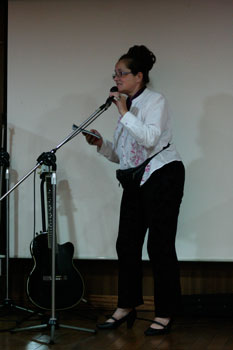
Chantal Morel, Tribute to the AIZEN
Le Colloque international de Glasgow marque la première collaboration de l’AIZEN et de la Emile Zola Society London – qui, elle aussi a fêté ses vingt ans d’existence – et de ma première rencontre avec Anna.
A Glasgow, Geoff Woollen nous a conduits sur les pas de Charles Rennie MacIntosh et fait dansé ou plutôt nous a appris les bases de la “Postie’s Jig”, une danse typiquement écossaise. Nous avons goûté au haggis, le plat national écossais c’est-à-dire un estomac de mouton farci, et – bien sûr – nous avons eu l’occasion d’écouter d’excellentes communications.
Depuis 1991, l’AIZEN a organisé de nombreuses rencontres à travers le monde parmi lesquelles celles de Philadelphie, New York, Rio de Janeiro, Edmonton et Jaén, offrant aux doctorants et aux chercheurs une plateforme pour présenter leurs travaux.
“Melting Pot”, “Pot-Bouille” l’AIZEN est un lieu de rencontres internationales et de débats sur Émile Zola et le naturalisme. Personnellement, l’AIZEN m’a permis non seulement de présenter mes travaux de recherche, mais aussi de développer mon goût pour les voyages et surtout de rencontrer de nombreux chercheurs qui, au fil des ans, sont devenus de véritables ami(e)s.
En dehors de l’AIZEN, j’ai retrouvé Anna à Cairns, en Australie, au cours d’un colloque où je présentais une communication sur “la Ville dans Les Rougon-Macquart”. De très belles excursions dans la forêt profonde et le long des rivières, ainsi que des plats locaux où crocodile et kangourou étaient au menu !
Merci à l’AIZEN et à son Comité de gestion, merci à Anna pour ces opportunités sans cesse renouvelées depuis 20 ans !
Longue vie aux études zoliennes et naturalistes. Longue vie à l’AIZEN et à ses membres. Chantal S. Morel, The Emile Zola Society London, England
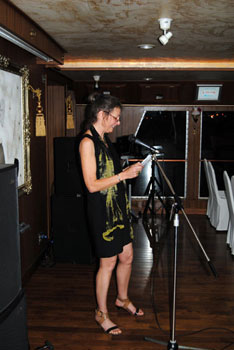
Marie-Sophie Armstrong, Tribute to the AIZEN
C’est un grand plaisir pour moi de pouvoir faire ces quelques remarques en l’honneur de ma collègue et amie Anna. Présidente de l’association AIZEN et directrice de la revue Excavatio Anna a, en l’espace de vingt ans, contribué de manière essentielle à l’expansion des études naturalistes et à notre connaissance de celles-ci. Ce n’est rien moins en effet qu’un continent littéraire jusque là inconnu ou très peu identifié, celui de l’héritage naturaliste à travers le monde, que, sous l’impulsion d’Anna, l’AIZEN a su mettre à jour. Au fil des colloques de l’association et des articles d’Excavatio les chercheurs ont ainsi vu leur compréhension du naturalisme franchir les frontières de la France puis celles de l’Europe. Ils ont eu la surprise de découvrir l’extraordinaire portée du mouvement dans le monde entier et l’influence de Zola sur la littérature de pays aussi géographiquement éloignés et culturellement divers que, pour n’en citer que quelques-uns, la Finlande, le Brésil, ou la Corée.
Sa remarquable force de travail, son énergie hors du commun, sa patience et sa gentillesse, ont permis à Anna d’organiser, avec l’aide de précieux collaborateurs tels que Carolyn Snipes-Hoyt et Robert Singer, des colloques qui permettent de reserrer le réseau naturaliste et font découvrir aux chercheurs de nouveaux horizons de recherche tout en leur donnant l’occasion de goûter la culture d’autres pays avec des collègues devenus des amis. Je n’oublierai pas pour ma part le magnifique concert de musique brésilienne entendu à la casa de Rui Barbosa, ni les paysages de prairies entourant Edmonton au Canada, ou la si jolie ville de Jaén au cœur de l’Andalousie! Un colloque AIZEN est toujours une occasion de se réjouir.
Anna, pour ta dévotion ininterrompue aux études naturalistes, pour tous ces amis, pour tous ces pays, je te dis merci!
Marie-Sophie Armstrong, Lehigh University, USA
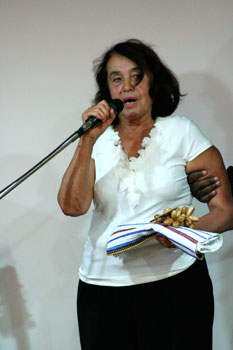
Anna Bondarenco, Tribute to the AIZEN
Écrire à l’occasion du vingtième anniversaire de l’AIZEN, pour un professeur chercheur qui enseigne comme moi en Moldavie, c’est me voir donner l’opportunité de mettre sur papier au moins une partie de ce que j’ai vécu, échangé, acquis aux côtés de l’excellent groupe de chercheurs francophones, anglophones et hispanophones, rassemblés autour de la Présidente de l’Association, Mme le Professeur Anna Gural-Migdal. Une telle passion pour l’œuvre zolienne pousse cette chercheuse de renom et son équipe à vouloir effacer les distances qui nous séparent et à nous réunir, pour qu’ensemble, nous prenions conscience de l’interaction qui existe entre l’être humain et la nature, une des idées centrales du naturalisme de Zola, que le Dr Chiu-Yen Shih a soulignée en ces termes lors du colloque de Pusan: “… l’alliance de l’homme sensible et de la nature agissante.”
Les efforts qu’Anna Gural-Migdal déploie en permanence, son efficacité en tant qu’organisatrice de colloques, les liens chaleureux qu’elle noue avec les participants en entretenant une correspondance régulière avec eux, ses compétences en matière de naturalisme, de théories littéraires et filmiques, son sérieux et sa rigueur scientifique, sa remarquable intelligence et le don qu’elle a de lire dans la nature humaine et d’interagir avec l’Autre, ont hautement contribué à la constitution d’une équipe de chercheurs, d’une grande “famille zolienne” dont les ramifications s’étendent désormais sur tous les continents. Ces chercheurs ne se lassent pas de creuser l’œuvre de Zola, d’examiner son influence sur les écrivains, artistes et intellectuels de différentes époques et en provenance des quatre coins du monde. Cela s’explique, à mon avis, par le fait que la nature humaine et la nature en tant que telle sont conçues chez les naturalistes, comme catégories prioritaires de l’observation et de l’analyse, comme valeurs suprêmes de notre existence.
Je profite de cette occasion pour exprimer ma profonde reconnaissance à vous, chère Anna, et aux membres dévoués du comité exécutif de l’AIZEN, grȃce auxquels j’ai pu découvrir de nouvelles perspectives et approches sur le naturalisme, échanger des vues sur la manière de conceptualiser et de créer des œuvres littéraires ou filmiques, me familiariser avec de nouveaux horizons socioculturels, entendre différentes façons de parler français dans un contexte de mondialisation. J’ai été heureuse de m’ouvrir par le biais des trois colloques auxquels j’ai participé – ceux de San Antonio aux États-Unis en 2003, de Rio de Janeiro au Brésil en 2004, et de Pusan en Corée du Sud en 2011 – à l’interprétation des principes naturalistes en fonction de divers champs d’études tels que, par exemple, la linguistique et la sémiotique, la médecine et la psychanalyse, l’histoire et la sociocritique.
J’ai par ailleurs beaucoup appris à propos de la réception du naturalisme dans de nombreux pays, en particulier sur les modifications qu’il a subies au moment où il est entré en relation avec des cultures nationales, avec divers types d’écriture pratiqués par des romanciers européens, américains, asiatiques, ou africains. Il est intéressant que les colloques AIZEN se soient aussi penchés sur des questions telles que le rôle de la traduction dans la diffusion de la méthode de représentation naturaliste, les modalités d’adaptation cinématographique des romans de Zola, les nouvelles tendances et interprétations de ce qui était considéré au départ comme un courant littéraire, et sur nombre d’autres problématiques plus intéressantes les unes que les autres.
L’organisation de telles rencontres internationales est une bonne occasion de se mettre en contact avec des chercheurs de toutes les nationalités et des universités du monde entier. Cela permet également de mettre en valeur la création littéraire de ce romancier de génie qu’est Zola, et d’approfondir les études sur lui en fonction du pays qui accueille le colloque. Collecter de l’information sur les formes de manifestation du naturalisme dans l’œuvre d’écrivains représentatifs de la culture hôte et de ses particularités régionales, ou locales, voilà un des buts importants que l’AIZEN se propose en matière de recherche. Une autre visée scientifique qui pose les fondements de cette Association, est sans nul doute celle d’analyser certains aspects de l’œuvre zolienne ou du naturalisme selon des approches théoriques et interdisciplinaires inédites, qui nous permettent d’envisager la littérature de manière novatrice. Après vingt ans d’existence et par le travail rigoureux de sa Présidente et de son équipe, l’AIZEN, en tant que société savante, a acquis une renommée bien méritée et s’est transformée en une véritable communauté de diffusion et de recherche des nouvelles formes de mise en œuvre des principes de la doctrine naturaliste, à travers le monde.
Les célébrations du vingtième anniversaire de l’AIZEN se sont déroulées dans une des plus prestigieuses institutions académiques de la Corée du Sud, l’Université Nationale de Pusan. Le choix de cet établissement s’explique par l’intérêt de longue date que Monsieur le Professeur Sang-Koo Kim, spécialiste réputé de naturalisme américain, a pour l’AIZEN puisqu’il a participé au colloque de Glasgow en 1998 et à celui de Jaén en 2002. Sa fidélité et son dévouement ont hautement contribué au succès éclatant de l’événement. Je tiens à lui exprimer toute ma gratitude, ainsi qu’aux membres de son comité d’organisation local constitué de Messieurs les Professeurs Il-Jae Jo et Wang- Joo Lee. Également un généreux merci aux autres organisateurs, Carolyn Snipes-Hoyt, Jeremy Worth, Riikka Rossi et Justine Huet, qui ont offert leur assistance courtoise et efficace pour faire en sorte que notre séjour à Pusan reste inoubliable.
L’AIZEN et sa Présidente ont relevé avec brio le défi de nous offrir un colloque anniversaire d’une grande richesse et de nous rassembler aussi loin qu’en Asie, pour continuer à redonner de la vie et du souffle au naturalisme, à bâtir son avenir en lui attribuant de nouvelles dimensions, car les communications présentées et leur qualité scientifique ont une fois de plus témoigné du renouveau du naturalisme à travers les œuvres contemporaines qui portent son empreinte.
Anna Bondarenco, State University of Moldava, Moldava

Christina Mbarga, Tribute to the AIZEN
Je ne sais par où commencer pour rendre hommage à l’AIZEN pour ses 20 ans d’existence. Il y a tant de choses à dire! Néanmoins, je me limiterai à l’essentiel.
Premièrement, merci pour cette occasion de pouvoir fêter l’anniversaire de l’AIZEN, et de le fêter à Pusan, en Corée du Sud, dans un cadre des plus magnifiques.
Ma première conférence AIZEN a été celle de San Francisco en 1999 alors que j’étais encore étudiant en doctorat. Ce qui m’a le plus frappé était l’esprit de convivialité et de famille que j’ai trouvé au sein de l’AIZEN. J’ai assisté à de nombreuses conférences sur plusieurs continents couvrant divers domaines. Nulle part ailleurs, je n’ai trouvé cet esprit de partage, de soutien, d’entraide. Qu’il s’agisse de San Antonio ou Rio en passant par Philadelphie, l’hébergement, l’organisation des conférences, la qualité des communications, le programme culturel, mais aussi la simplicité des participants m’ont toujours charmé; à chaque retour d’une conférence AIZEN, je reviens comblé, même si c’est toujours à regret que je quitte mes amis.
Les conférences AIZEN m’ont apporté beaucoup tant du côté intellectuel qu’humain, expériences enrichissantes inégalables, tout en me motivant. Si je parle portugais aujourd’hui, c’est grâce à l’AIZEN! Non, l’AIZEN ne donne pas des cours de langue, c’est la tenue de ses conférences à travers le monde qui nous permet ce cheminement vers l’autre. Mon premier séjour au Brésil, dans le cadre d’une conférence AIZEN, a accentué mon besoin naturel d’ouverture et la curiosité de savoir plus. En effet, une très grande majorité de personnes au Brésil s’expriment uniquement en portugais, leur langue maternelle. En raison de mon ignorance de son contexte linguistique et de sa langue, je n’ai pas pu profiter de tout ce que ce pays avait à offrir, malgré ma connaissance de plusieurs langues. Après la conférence AIZEN de Rio en 2004, je me suis donc donné pour objectif d’apprendre le portugais. A présent que je parle cette langue et que je me suis fait des amis au Brésil, mon horizon s’est agrandi davantage, et j’ai la possibilité de passer mon prochain congé sabbatique dans une université de ce pays fascinant.
Pourrait-on rendre hommage à cette association des études zoliennes sans mentionner celle que je nomme ‘la fée de l’AIZEN’, la mère qui s’assure que tout est bien fait, que la famille a tout ce qu’il faut, toujours aux petits soins pour tous? Infatigable, première levée, elle est aussi la dernière couchée. Anna Gural-Migdal, vous l’avez deviné, est bien cette fée, l’âme qui insuffle sa vision et sa vivacité à l’AIZEN. Comme moi, plusieurs participants aux conférences AIZEN y vont depuis leurs études doctorales. Anna nous a toujours soutenus, tout en suivant nos progrès, écrivant une lettre de référence par-ci, un mot d’encouragement par-là, comme une mère veillant sur sa progéniture. Et une mère au sens noble du terme! Il est évident que j’ai beaucoup d’affection pour Anna…et je ne puis l’exprimer autrement. Chère Anna, merci pour tout.
Un hommage à l’AIZEN ne saurait se faire sans que soient mentionnés les autres membres de cette grande famille. Mes remerciements vont également à la grande équipe qui entoure Anna depuis de nombreuses années et qui fait un travail formidable en mettant un nombre incalculable d’heures pour assurer la réussite des conférences et autres rencontres AIZEN. Merci Carolyn, merci Jeremy, merci Riikka, merci à tous les autres que je ne puis nommer ici, car c’est aussi grâce à vos efforts que l’AIZEN existe et croît.
Christian Mbarga, St-Thomas University, Canada
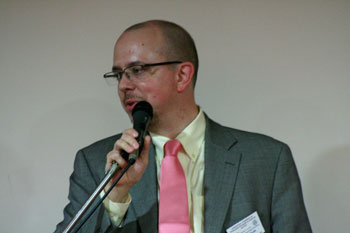
Jeremy Worth, Tribute to the AIZEN
I first met Anna Gural-Migdal a dozen years ago, when she hosted the 9th AIZEN conference and Naturalist Film Festival in Edmonton, at the University of Alberta. At that early stage of my PhD studies, I had presented only a couple of conference papers and was, in every sense, still finding my feet in the milieu. That conference allayed many fears and brought inspiration as well as reassurance. Anna was an attentive and interested host who seemed to know who everybody was, my trepidatious self included, as soon as we walked into the lobby at Lister Hall. I remember her in full flow that morning, making introductions, breaking ice, greeting participants and putting everyone at their ease. With a host so perfectly in her element and in such an atmosphere of bonhomie it was easy to relax enough to lose oneself in the presentations which, as always at the AIZEN, were lively, thought-provoking and of the highest intellectual merit. The thoroughly fun outing that Anna organised to Jasper provided the opportunity to get to know her, Carolyn Snipes-Hoyt and other AIZEN regulars better – this would be my first experience of the convivial AIZEN atmosphere and of special association events filled with laughter and song.
In the months that followed, Anna was regularly in touch with the conference participants, and my first impressions were confirmed by personal greetings added to form letters, by copies of photographs generously shared, and by the speed and efficiency of the Excavatio editorial process, led by Anna with the able and indispensable support of Carolyn and the reading committees. As a postgraduate student I felt very privileged to be included in that year’s AIZEN group and to be published in Excavatio – a valuable experience and a great fillip for a young researcher. Attending other conferences over the following months, I spoke to many students and junior faculty members who had been helped, supported and encouraged by Anna in any number of ways over the years.
This picture of Anna, the tireless champion of Zola and Naturalism, of all the arts and of a new generation of researchers, came fully into focus at the next meeting of the AIZEN, in Philadelphia in October 2001. The events of 9/11 were only weeks in the past and air travel had become a tense affair. Cancellations might quite understandably, and perhaps even justifiably, have flooded in from that year’s presenters; the fact that they did not is in very large part due to everyone’s desire to get back together, to carry on and to do justice to Anna, Carolyn and Robert Singer’s vision, unflagging energy and enthusiasm. It would be inaccurate to suggest that 9/11 cast no pall over the proceedings, but the spirit of 2000 was nevertheless rekindled and Anna was once again at the centre of an unforgettable event, bringing together researchers, generating sparks and encouraging junior scholars.
I rather lost touch with the AIZEN over the next few years, as I approached the end of my PhD, began my full-time career and started a family. Faithful as always to the AIZEN’s members, however, Anna did not fail to include my tenure-track post at the University of Windsor in the AIZEN Bulletin’s news and congratulations section, and soon we were back in contact. I had heard, from many sources, of the resounding success of the conferences I had missed, and I was keen to take part again when circumstances allowed it. That opportunity came with the inspiring and rejuvenating 2008 Helsinki conference, so beautifully organised by Riikka Rossi, where Anna greeted us with the same warmth as in 2000 and 2001 and where the spirit of the AIZEN reigned yet again.
To be involved in the organising of the 2011 Pusan conference has been an honour and a privilege. Heartfelt thanks must go to Dr. Kim Sang-Koo and to all members of the team, including the student volunteers, as well as to all the participants. So much has been achieved in 2011. But the greatest thanks of all must go to Anna Gural-Migdal for all that she has done, initially alongside Monique Fol and then as president of the AIZEN herself, since 1999. So many are in your debt, and all are grateful for your dedication, brilliance and generosity.
Jeremy Worth, University of Windsor, Canada

Riikka Rossi, Tribute to the AIZEN
My journey with the AIZEN started in 2002 in Jaén, Spain. I was a doctoral student; it was my first conference abroad, my first paper given in French. I was very young and far away from home in Finland.
Since Jaén the association has open up many paths for me, both intellectually and in friendship. I have collaborated with Anna in many ways, and in 2008 we organized an AIZEN conference in Helsinki.
Anna, I have always appreciated your open-minded way of working with young scholars coming from foreign countries. The academic world may sometimes be hard and competitive, and there is never too much room for associations like the AIZEN, with such a positive, encouraging spirit.
Riikka Rossi, University of Helsinki, Finland

Mihaela Marin, Tribute to the AIZEN
Je suis membre de l’AIZEN depuis 1996. Je n’oublierai jamais ma première participation à la série de colloques internationaux organisés par cette association de prestige, car elle fut en effet remarquable en ce qui me concerne. Après l’acceptation de ma communication, je suis tombée malade et, au moment de la conférence, je ne suis pas allée à New York où l’AIZEN organisait son cinquième colloque. Mais le comité d’organisation a pris la décision d’inclure tout de même ma communication dans le programme et de la faire lire par un de ses membres en mon absence À la fin du colloque, je me suis vue décerner le Prix AIZEN (AIZEN Award devenu par la suite Schor/Cahm Award) pour la meilleure communication présentée par un(e) étudiant(e) au doctorat. Ce fut le début d'une riche collaboration professionnelle que j’ai développée, au cours des années, avec les membres de l’Association et surtout avec Anna Gural-Migdal, la présidente de l’AIZEN.
J’ai obtenu mon PhD en 1999 et j’ai démarré ma carrière de professeur spécialisé en littérature française du XIXe siècle à Ohio State University. Ma participation aux prestigieux colloques internationaux que l’AIZEN a organisés (Etats-Unis, Canada, Écosse, Espagne, Corée du Sud), les articles publiés dans Excavatio et dans les volumes sous la direction de Anna Gural-Migdal et des membres de l’équipe AIZEN ont joué un rôle important en ce qui a trait à ma formation de dix-neuviémiste. Anna Gural-Migdal et son équipe ont toujours soutenu les doctorants et les chercheurs en début de carrière. Anna a généreusement accepté d’écrire des lettres de recommandation, si importantes dans la carrière académique, et de fournir des références pour nous soutenir à tout moment, que ce soit dans nos recherches de poste, nos demandes de bourse, de titularisation et de promotion, ou encore dans la soumission de nos articles. Avec beaucoup de patience et sollicitude, elle a passé en revue tout le matériel soumis à son attention. Elle a trouvé le temps de lire et d’évaluer nos manuscrits et nos publications, de parcourir tous les dossiers volumineux qu’on a soumis à sa critique.
Anna et son équipe ont joué un rôle essentiel dans nos carrières. Comme cela a été mon cas, beaucoup de doctorants et de professeurs débutants sont devenus des spécialistes de littérature et culture du dix-neuvième siècle grâce au soutien de l’AIZEN, présidée par Anna Gural-Migdal. On ne peut qu’espérer que cette association continue son impressionnante activité dans les années à venir.
Mihaela Marin, University of South Alabama, USA

Lisa Ng, Tribute to the AIZEN
I joined the AIZEN in 2000 when I was a graduate student. I am thankful to Dr. Anna Gural-Migdal who, that year, gave me a reading course on Zola and introduced me to the association. During the past 11 years, the conferences have become a medium for me to express and publish my ideas, continually spurring me on to renew my knowledge in the field of naturalism. I am glad to have been able to follow the AIZEN to some of its most important conferences, such as the ones in Finland and Korea. I still remember that my first conference in Edmonton was a frightening experience, where I was surrounded by renowned researchers; I am amazed how much I have grown since then, as I speak to you tonight without that fear anymore.
Becoming a member of the association has also given me the opportunity to maintain personal contact with important scholars. In 2009, I had the honor of hosting Dr. Rikka Rossi and Dr. Anna Gural-Migdal in my home in Calgary. We enjoyed some inspiring conversations on Zola and we spent some precious time together.
I would like to thank Dr. Gural-Migdal for all the opportunities she has given me. I am very proud to be part of the AIZEN legacy. Thanks also go to her team which has contributed to the success of all the conferences and helped make them a valuable experience for researchers.
Lisa Ng, Mount Royal University, Canada
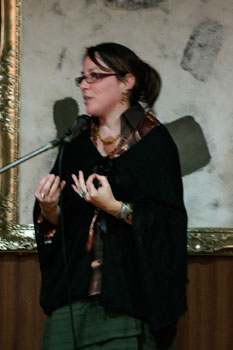
Rosemary Peters, Tribute to the AIZEN
Discovering AIZEN opened a new chapter in my academic life. I saw the Call For Papers for the Glasgow conference (1998) shortly after I had completed my general exams and was somewhat reeling from the experience. That conference gave me the impetus to put some of my ideas to paper, and the community I discovered in Glasgow gave new life to my academic trajectory. That was my first conference presentation, and an excellent introduction to the professional world of literary scholars. It was an honor beyond description to receive the AIZEN Award for my paper that year, especially amidst so many talented and eloquent (and far more experienced) scholars; and then to see that paper published – also my first publication. While I have not been able to attend every AIZEN meeting, over the years I have found the organization to be as welcoming and stimulating as that first experience promised. In New York (2006) I learned about Naturalist Cinema from dozens of points of view; in Busan (2011) I discovered Korean film and a blossoming international community of thinkers and colleagues globe – and singers, especially when presented with a nineteenth-century song about Naturalism!
My homage would fall flat if I did not mention the specific role Anna Gural-Migdal has played in my own acquaintance with AIZEN. From our very first meeting, Anna has been unfailingly warm, encouraging, and inspirational. Her energy and enthusiasm – for everything about Zola, for writing and publishing, for supporting junior colleagues, for organizing conferences all across the globe – has provided a model for a new kind of academia, engaged and interdisciplinary and border-challenging. Whenever I think I am too tired to do one more thing for one more student, or article, or CFP, I think of Anna and get back to it. Thank you to Anna for dedication, direction, inspiration, encouragement, and friendship. I hope to emulate Anna's example with my own students and junior colleagues.
I am thrilled and honored to lift a glass to the AIZEN, and to its President.
Rosemary Peters, Louisiana State University, USA

Jean-Sébastien Macke, Tribute to the AIZEN in Song
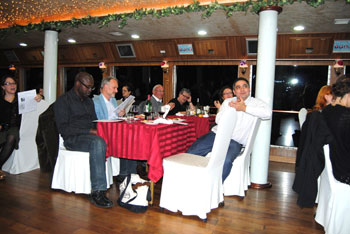
Guests Singing
Nineteenth-Century Song as a Tribute to the AIZEN: “Je suis naturaliste!”


